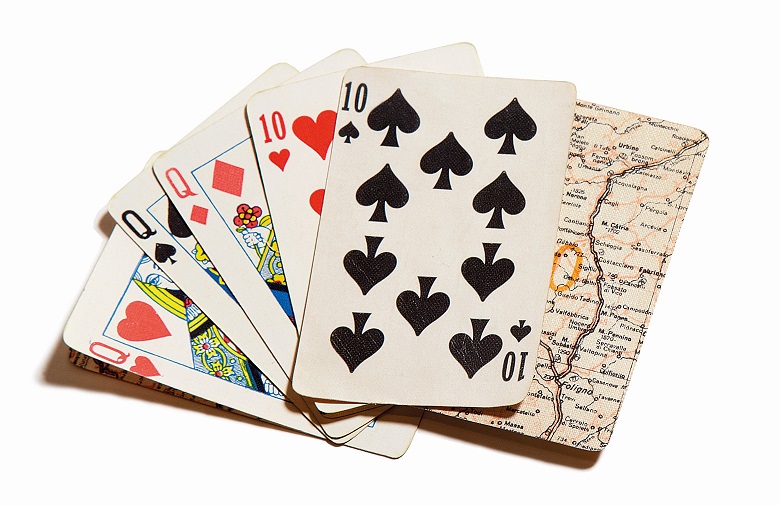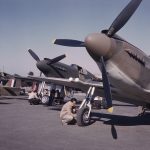By Noah Stegman Rechtin
If the frequency of posts on the r/aviation subreddit is any indication, the problem of what to do with a relative’s collection of aviation memorabilia is a common one. Often, those who receive the collection are not nearly as familiar with the material as the original owner. Naturally, then, the question arises: What should they do with the collection? One recurring suggestion is to donate the materials to an aviation museum. As someone who has handled donations at an aviation museum for over five years, this is a situation I have encountered a lot.
Most museums would be thrilled to take a look at what you have. They hate to see things go into the dumpster, so please reach out! However, there are some things you should know before making a donation:
1. Consider which museum would be most appropriate for the items.It may not be the closest museum to you. For example, the National Museum of the United States Air Force would not be interested in the collection of a naval aviator, but the National Naval Aviation Museum would. Did your relatives move when they retired? If so, there’s a good chance that their collection has more value to the community where they lived when they were active.
2. Do not just walk in or drop things off.This is the biggest pet peeve of people who handle donations. Indeed, many museums will not accept items without an appointment. Instead, contact the museum ahead of time.
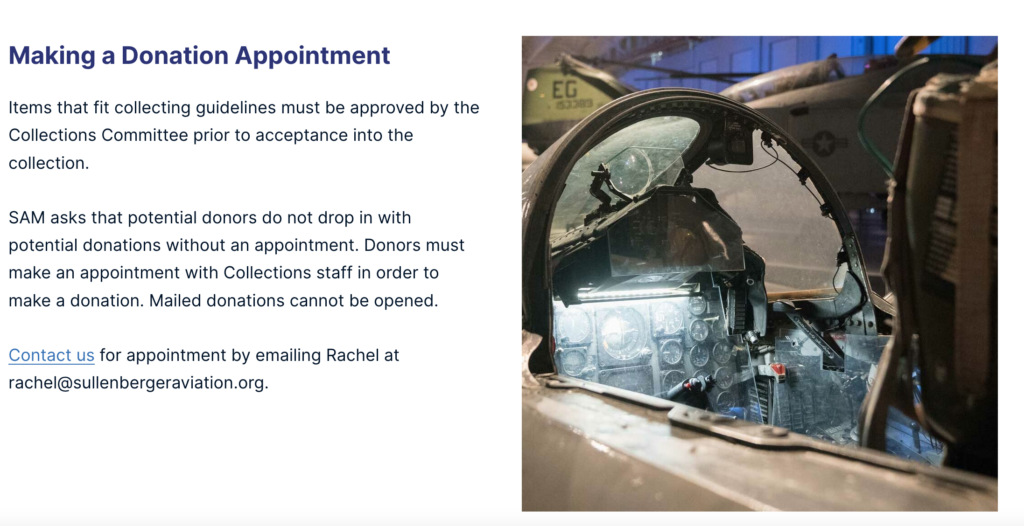
This isn’t because they aren’t interested, but because the decision needs to be made by an expert. While the volunteer at the front desk may be helpful, odds are they are not properly trained on how to process donations or what the museum is willing to accept.
For instance, most museums have limited storage space and have to make decisions about what to take. So, if they already have an example of what you are offering, they may turn your offer down. However, if you speak with them first, they might know of another museum across town (or the country) that is looking for that very thing!
Ian McCollum of the YouTube channel Forgotten Weapons has an excellent video that goes into more detail on the thinking behind some of these decisions. Check out the video below.
Another issue is that many materials in aviation are hazardous, and, in the case of military museums, even explosive! 3. Provide as much detail as possible.Good museums have certain self-imposed rules, called a collections management policy (for example that of the San Diego Air and Space Museum), which provides guidance about what they can accept. The more they know, the easier it is for them to make a decision.
The value of an artifact comes from the story it can tell. If the information about where it came from, called provenance, is lost, it is far less historically valuable. Some museums have questionnaires attached to their deed of gift for this purpose. However, feel free to provide your own write-up as well. It is exceedingly rare that a donor provides too much information. For example, if your relative was a veteran, a copy of their discharge paperwork is excellent for this purpose as it provides a succinct, but detailed summary of their military service.
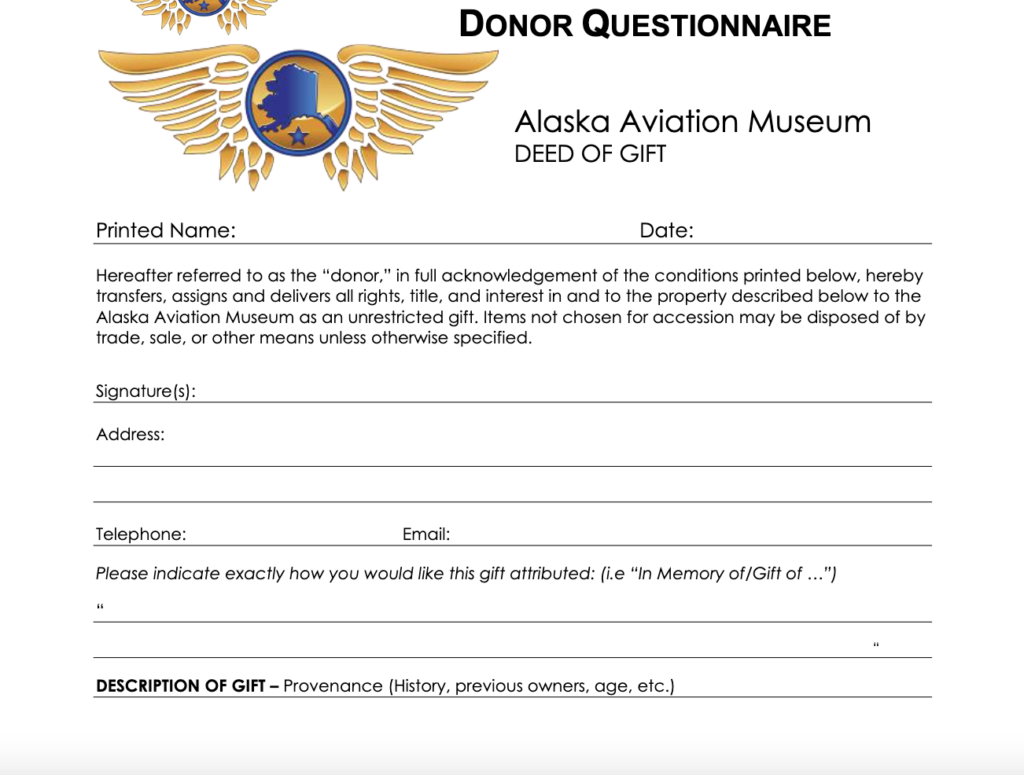
If your initial contact with the museum is via email, make sure to attach at least a few pictures of the artifacts. It is often said that a picture is worth a thousand words and this is certainly true with donation offers.
4. Don’t place conditions on your donation.Many museums won’t accept the collection if you do. The problem of “permanent loans” has been a long running one in the field because it results in an object that the museum doesn’t control, but must care for and store. The storage hangars at the National Museum of the United States Air Force are packed full of airplanes that they lack the room to display. Check out the video below.
Keep in mind that most museums have the vast majority of their collection in storage, so don’t expect to see it on display any time soon. However, this does not mean that it is not valuable to the museum. Researchers may come in to study them or they may be used for a future exhibition.
So how do I find a museum?
The Wikipedia article List of aviation museums is fairly comprehensive and a good place to start, so check it out to see if there is one near you.
What to expect?
Different museums have different approaches to the donation process. Some museums employ a temporary custody system in which the donor leaves the artifacts with the museum and is given a receipt. A collections committee composed of the heads of each major collection at the museum – for example, permanent, education and working – then meets to evaluate the offer. They then vote and the potential donor is asked to return to the museum to either sign a deed of gift or pick up the objects based on whether the donation is accepted or rejected.
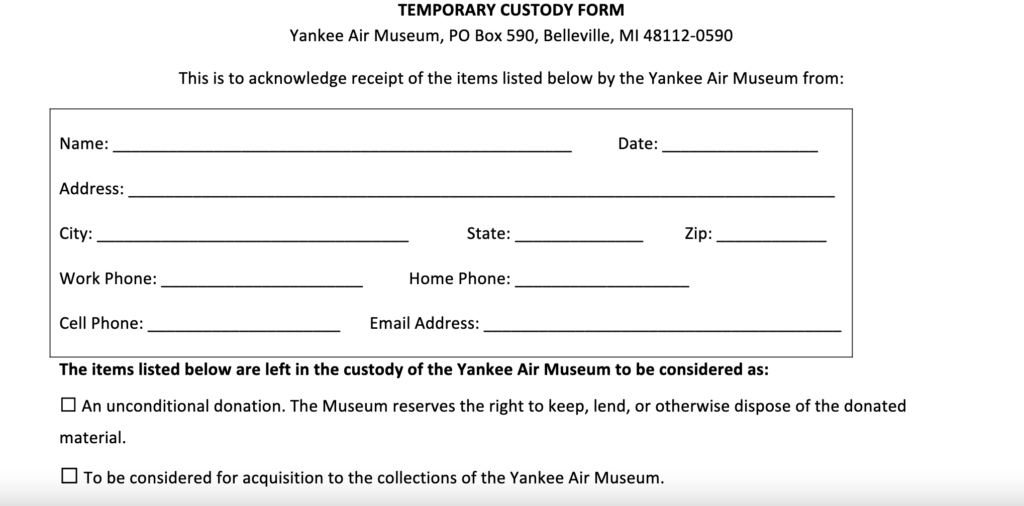
However, this process is time- and labor-intensive as it usually takes a few weeks for the committee to meet and requires the donor to visit the museum more than once. This can be problematic as many donors simply want to be complete the donation as quickly and easily as possible. Therefore, some museums skip the temporary custody process and simply reduce the process to a single visit.
Regardless of which method is used, you will be asked to sign a deed of gift. You may think this is a mere formality, but this step is completely necessary and any museum worth its weight in salt will not accept your donation without it.
In addition to ensuring that the museum has a valid legal title to the physical object, a good deed of gift will also transfer any intellectual property rights as well. With many museums choosing to digitize their collections (as we previously discussed here) to make it available online, this aspect has become even more important. Without ownership of the copyright, legal restrictions can keep valuable artifacts locked away from the public.
Now you know!
So, in conclusion, if your parent or grandparent left you a collection of aviation memorabilia and you’re not sure what to do with it, please consider speaking with an aviation museum. A donation can be one of the best ways to honor your ancestor’s military service or to share the enthusiasm and devotion that a collector had for the subject with the public.







